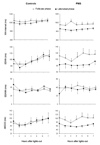Reduced parasympathetic activity during sleep in the symptomatic phase of severe premenstrual syndrome
- PMID: 18582607
- PMCID: PMC2519123
- DOI: 10.1016/j.jpsychores.2008.04.008
Reduced parasympathetic activity during sleep in the symptomatic phase of severe premenstrual syndrome
Abstract
Objective: Severe premenstrual syndrome (PMS) is a common distressing disorder in women that manifests during the premenstrual (late-luteal) phase of the ovulatory menstrual cycle. There is some evidence that altered autonomic function may be an important component of PMS, but few studies have used heart rate variability (HRV) as a sensitive marker of autonomic activity in severe PMS, and findings are conflicting.
Methods: We investigated HRV during sleep, a state that is relatively free of external disruptions, in 9 women with severe PMS and 12 controls.
Results: The normal-to-normal (NN) RR interval was shorter during the sleep period in women with PMS than in controls in both the follicular and the late-luteal phases of the menstrual cycle. The standard deviation of all NN intervals, a measure of total variability in the interbeat interval, was lower during the sleep period in the late-luteal phase than in the follicular phase in women with PMS. The square root of the mean of the sum of the squares of differences between adjacent NN intervals, a measure reflecting high-frequency (HF) activity, showed a similar pattern. HF power, a marker of parasympathetic activity, was lower during non-rapid eye movement (non-REM) and REM sleep in the late-luteal phase than in the follicular phase in women with severe PMS. Controls had a shorter NN interval, but similar HRV measures, in the late-luteal phase compared with the follicular phase.
Conclusion: These results suggest that women with severe PMS have decreased parasympathetic activity during sleep in association with their premenstrual symptoms in the late-luteal phase compared with the follicular phase when they are symptom-free.
Figures


Similar articles
-
Autonomic regulation across phases of the menstrual cycle and sleep stages in women with premenstrual syndrome and healthy controls.Psychoneuroendocrinology. 2013 Nov;38(11):2618-27. doi: 10.1016/j.psyneuen.2013.06.005. Epub 2013 Jul 10. Psychoneuroendocrinology. 2013. PMID: 23850226 Free PMC article.
-
Sleep quality and the sleep electroencephalogram in women with severe premenstrual syndrome.Sleep. 2007 Oct;30(10):1283-91. doi: 10.1093/sleep/30.10.1283. Sleep. 2007. PMID: 17969462 Free PMC article.
-
Autonomic nervous system activity in the late luteal phase of eumenorrheic women with premenstrual symptomatology.J Psychosom Obstet Gynaecol. 2006 Sep;27(3):131-9. doi: 10.1080/01674820500490218. J Psychosom Obstet Gynaecol. 2006. PMID: 17214447
-
Acupuncture and acupressure for premenstrual syndrome.Cochrane Database Syst Rev. 2018 Aug 14;8(8):CD005290. doi: 10.1002/14651858.CD005290.pub2. Cochrane Database Syst Rev. 2018. PMID: 30105749 Free PMC article.
-
Altered serotonergic activity in women with dysphoric premenstrual syndromes.Int J Psychiatry Med. 1993;23(1):1-27. doi: 10.2190/J2W0-RTGD-NYKK-FF77. Int J Psychiatry Med. 1993. PMID: 8514462 Review.
Cited by
-
Effects of olfactory stimulation from the fragrance of the Japanese citrus fruit yuzu (Citrus junos Sieb. ex Tanaka) on mood states and salivary chromogranin A as an endocrinologic stress marker.J Altern Complement Med. 2014 Jun;20(6):500-6. doi: 10.1089/acm.2013.0425. Epub 2014 Apr 17. J Altern Complement Med. 2014. PMID: 24742226 Free PMC article. Clinical Trial.
-
The Effects of Sertraline in Controlling Refractory Hypertension in Women with Premenstrual Syndrome.Iran J Psychiatry. 2016 Oct;11(4):234-238. Iran J Psychiatry. 2016. PMID: 28050183 Free PMC article.
-
Pulse Rate Measurement During Sleep Using Wearable Sensors, and its Correlation with the Menstrual Cycle Phases, A Prospective Observational Study.Sci Rep. 2017 May 2;7(1):1294. doi: 10.1038/s41598-017-01433-9. Sci Rep. 2017. PMID: 28465583 Free PMC article.
-
The behavioral and physiological correlates of affective mood switching in premenstrual dysphoric disorder.Front Psychiatry. 2024 Nov 4;15:1448914. doi: 10.3389/fpsyt.2024.1448914. eCollection 2024. Front Psychiatry. 2024. PMID: 39559281 Free PMC article. Review.
-
Autonomic regulation across phases of the menstrual cycle and sleep stages in women with premenstrual syndrome and healthy controls.Psychoneuroendocrinology. 2013 Nov;38(11):2618-27. doi: 10.1016/j.psyneuen.2013.06.005. Epub 2013 Jul 10. Psychoneuroendocrinology. 2013. PMID: 23850226 Free PMC article.
References
-
- Freeman EW. Premenstrual syndrome and premenstrual dysphoric disorder: definitions and diagnosis. Psychoneuroendocrinology. 2003;28 Suppl 3:25–37. - PubMed
-
- Halbreich U. The etiology, biology, and evolving pathology of premenstrual syndromes. Psychoneuroendocrinology. 2003;28 Suppl 3:55–99. - PubMed
-
- Girdler SS, Pedersen CA, Straneva PA, Leserman J, Stanwyck CL, Benjamin S, Light KC. Dysregulation of cardiovascular and neuroendocrine responses to stress in premenstrual dysphoric disorder. Psychiatry Res. 1998;81:163–178. - PubMed
-
- Palmero F, Choliz M. Resting heart rate (HR) in women with and without premenstrual symptoms (PMS) J Behav Med. 1991;14:125–139. - PubMed
-
- Girdler SS, Pedersen CA, Stern RA, Light KC. Menstrual cycle and premenstrual syndrome: modifiers of cardiovascular reactivity in women. Health Psychol. 1993;12:180–192. - PubMed
Publication types
MeSH terms
Grants and funding
LinkOut - more resources
Full Text Sources
Other Literature Sources
Medical
Research Materials
Miscellaneous

